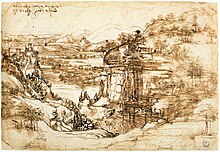Leonardo da Vinci
italian pronunciation
Leonardo da Vinci (English: /ˌliːəˈnɑːrdoʊ də ˈvɪntʃi, ˌliːoʊˈ-, ˌleɪoʊˈ-/;[a] 14/15 April 1452[b] – 2 May 1519)[4] was an Italian polymath of the High Renaissance who is widely considered one of the most diversely talented individuals ever to have lived.[5] While his fame initially rested on his achievements as a painter, he also became known for his notebooks, in which he made drawings and notes on science and invention; these involve a variety of subjects including anatomy, astronomy, botany, cartography, painting, and palaeontology. Leonardo's genius epitomized the Renaissance humanist idea,[6] and his collective works compose a contribution to later generations of artists rivalled only by that of his contemporary Michelangelo.[7]
Properly named Leonardo di ser Piero da Vinci,[c] Leonardo was born out of wedlock to a notary, Piero da Vinci, and a peasant woman, Caterina, in Vinci, in the region of Florence, Italy. Leonardo was educated in the studio of the renowned Italian painter Andrea del Verrocchio. Much of his earlier working life was spent in the service of Ludovico il Moro in Milan, and he later worked in Rome, Bologna and Venice. He spent his last three years in France, where he died in 1519.
Although he had no formal academic training,[8] many historians and scholars regard Leonardo as the prime exemplar of the "Renaissance Man" or "Universal Genius", an individual of "unquenchable curiosity" and "feverishly inventive imagination."[9] According to art historian Helen Gardner, the scope and depth of his interests were without precedent in recorded history, and "his mind and personality seem to us superhuman, while the man himself mysterious and remote."[9] Scholars interpret his view of the world as being based in logic, though the empirical methods he used were unorthodox for his time.[10]
Leonardo was born on 14/15 April 1452[b] in the Tuscan hill town of Vinci, in the lower valley of the Arno river in the territory of the Medici-ruled Republic of Florence.[20] He was the out-of-wedlock son of Messer Piero Fruosino di Antonio da Vinci, a wealthy Florentine legal notary, and a peasant named Caterina,[d] identified as Caterina Buti del Vacca and more recently as Caterina di Meo Lippi by historian Martin Kemp. There have been many theories regarding Leonardo's mother's identity, including that she was a slave of foreign origin or an impoverished local youth.[19][22][23][24][e] Leonardo had no surname in the modern sense—da Vinci simply meaning "of Vinci"; his full birth name was Lionardo di ser Piero da Vinci,[2][27] meaning "Leonardo, (son) of ser Piero (from) Vinci."[20][c]
In the mid-1460s, Leonardo's family moved to Florence, which at the time was the centre of Christian Humanist thought and culture.[38] Around the age of 14,[32] he became a garzone (studio boy) in the workshop of Andrea del Verrocchio, who was the leading Florentine painter and sculptor of his time.[38] This was about the time of the death of Verrocchio's master, the great sculptor Donatello.[g] Leonardo became an apprentice by the age of 17 and remained in training for seven years.[40][41] Other famous painters apprenticed in the workshop or associated with it include Ghirlandaio, Perugino, Botticelli, and Lorenzo di Credi.[29][42] Leonardo was exposed to both theoretical training and a wide range of technical skills,[43] including drafting, chemistry, metallurgy, metal working, plaster casting, leather working, mechanics, and wood-work, as well as the artistic skills of drawing, painting, sculpting, and modelling.[44][h]
Leonardo Paintings and Images



